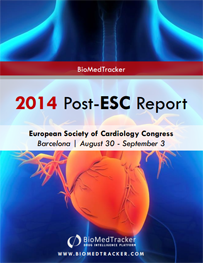Report Library
All Reports
2014 Post-ESC Report
September 25, 2014
The European Society of Cardiology (ESC) 2014 Congress was held in Barcelona, Spain from August 30-September 3, 2014. This year featured
groundbreaking data on LCZ696 in heart failure, showing a reduction in overall mortality, and important new Phase III data for PCSK9 inhibitor
alirocumab. There were also a number of interesting device studies presented.
Highlights from this year’s meeting include:
Heart Failure
For the full report, please download the PDF version at the top of this page or contact your sales representative.
For our disclosures, please read the BioMedTracker Research Standards.
- Strong showing for LCZ696 (NVS), with a 20% reduction in both cardiovascular death and hospitalization for heart failure. Safety was good, though the drug increased hypotension. LCZ696 could become a new standard in guidelines, though there are questions about which subgroups it may be most appropriate for, and given the moderate reduction in events, cost could still be an issue for some patients.
- Negative results for vagal nerve stimulation from Boston Scientific's NECTAR-HF raised serious doubts about the technology. The field will have to wait for results from INOVATE-HF next year to see if different dosage strategies may be more successful.
- Strong and consistent LDL-c lowering for several alirocumab (REGN, SNY) Phase III studies. Post-hoc benefit in MACE in ODYSSEY LONG
TERM could bolster confidence in FDA that PCSK9 inhibitors do reduce outcomes, but small number of events and results from COMBO II not
consistent.
- All eyes are on Vytorin's IMPROVE-IT at the AHA conference in November, which could confirm LDL-c as a biomarker, but given modest impact of ezetimibe, its data may not be definitive.
- We also include notes on PCSK9/CETP inhibitor competition.
- Data on ISIS-APOARx (ISIS) largely incremental. Reductions in Lp(a) were similar regardless of baseline levels. Company will be discussing possible registration trials with FDA at end-of-Phase II meeting, but presentation gave examples of studies that could be done.
- mPTP inhibitor TRO40303 (Trophos) had an unsuccessful Phase II proof-of-concept trial. Investigator said, given current standard of care, study raises question whether reperfusion injury really accounts for significant portion of remaining infarct after PCI.
- Ivabradine (Servier, AMGN) showed no benefit in SIGNIFY in patients with stable CAD and elevated heart rate, and appeared to worsen outcomes in large subgroup with Class II or higher angina. Investigators are still exploring cause of the latter. More details are needed to gauge implications for the heart failure submission in the US, since such patients may have ischemic etiology. However, there are arguments that could be made why the drug could be more effective in heart failure.
- Orsiro stent (Biotronik) with biodegradable polymer showed similar one-year outcomes as ABT's Xience. It had an advantage in STEMI patients, but on the negative side, a trend towards higher definite stent thrombosis. The rationale for a biodegradable polymer was questioned. More data on such stents is coming at the AHA.
- Shortly after the meeting, one-year interim results from ABSORB II for ABT's bioresorbable scaffold were presented at the Transcatheter Cardiovascular Therapeutics (TCT) conference. There were both potential positive and negative findings, but the study was too small to be definitive. The investigator of an optical coherence tomography (OCT) study suggested benefits could come later on, at least in some patients, but the study was single arm and quite small.
- Xarelto's (JNJ, BAYRY) X-VeRT, the first completed prospective trial of a novel oral anticoagulant in elective cardioversion of AF, bolstered post-hoc analyses of more general pivotal studies, numerically cutting in half the primary outcome of cardiovascular events, including stroke, without an increase in major bleeding. While not powered sufficiently, ESC discussant felt results should impact guidelines.
- Small molecule PER977's (Perosphere) first-in-man study showed rapid reversal of edoxaban effect as measured by clotting time.
For the full report, please download the PDF version at the top of this page or contact your sales representative.
For our disclosures, please read the BioMedTracker Research Standards.
| Disease Group Covered: | Cardiovascular |
Additional Resources:
